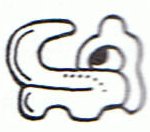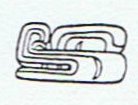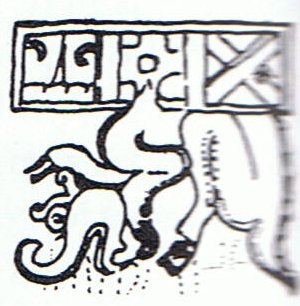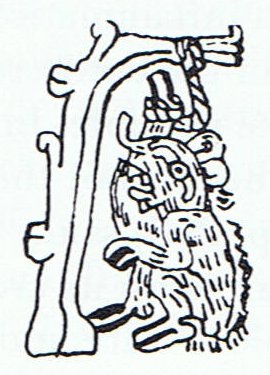|
The Yucatec word chac means 'red', but also 'great'. The KekchÝ name for Pop was Icat (Ekcat), and here the Yucatec name Zip is translated into Chaccat by the KekchÝ. Pop is the black (ek) cat, while Zip is the red (chac) cat. Presumably the 'crossed bar' sign is to be read as cat, because the top symbol in Gates' glyphs (example top right) means red (chac). The sign is inverted in the left of the two glyphs below. |
|
The common denominator between Pop and Zip is - I believe - their mobile character. Pop is a merchant and Zip a hunter. In the sky the planet which ambulates in Mars (and he is red when close and black when far away). Merchants live on being far away, while hunters cannot stray to far away. "The correctness of Thompson's identification of the head [top left] as being that of the so called Mars beast may be seen by comparing the glyphs of the two."
 
"The association of this reptilian peccary or deer with the Moon Goddess of the Aztecs or with Ix Chel of the Mayas is not clear." I can see a sign like a moon crescent below the eye in the Zip glyph, and possibly another half moon crescent inside the eye, a waning one. The black new moon can then, maybe, explain the black 'pupil' in the eye of the Mars beast. A confirmation of these ideas is in the top right sign in the Mars beast glyph (looking like the knob on top of some Disney figure). The association between Mars and Moon surely is their changing (living) character. The 'snout' in Zip and in the Mars beast glyphs must illustrate the strange ambulating path of Mars, a great voyager according to the Polynesians. 
|
|
"Another glyph, T794 [the so called Mars beast glyph above], represents an animal which is shown hanging from the sky in Dresden and Madrid.

It has been called the Mars beast because of its association with a table of multiples of 780 days ... Seeler drew attention to a representation which shows it with a quite long tail and a rather serrated back, as well as the hooves and elongated snout of the other representations.

He thought it was a composite 'lightning beast' with mixed characteristics. He also compares it with the crocodilian sky monster of Dresden, which is also depicted with hooves. Sky associations and peccary characteristics seem dominant, and I prefer to call it simply a 'sky peccary'." |
|
The two forces, which Gates reads in the crossed bar sign at bottom in Uo and Zip, probably symbolize the far away (black) Mars (Uo) and the close great (and red) Mars (Zip). Identifying Mars with a strange 'sky peccary' will then connect to the idea of creation of light in Gemini (also twins):
'... When I was drawing this bone, I noticed that the paddler in the picture was Itzamna, not the Old Jaguar Paddler or the Stingray Paddler from the other bones. Then the use of two different paddlers in these canoe scenes made me realize something. We have Classic-period pottery images of Itzamna riding a peccary (Fig. 2:26c). When the Milky Way is in the Cosmic Monster-canoe position, east-west across the sky, the peccary stars of Gemini are at the eastern end of the Milky Way (Fig. 2:26b). The peccaries are exactly where Itzamna sits as he wields his paddle. Also, Itzamna and the two Paddlers are three of the four stone-setters that are named in the Quirigua Creation text on Stela C. They are the makers, along with First Father, of the First-Three-Stone-Place raised up into the night sky on 4 Ahaw 8 Kumk'u ...'

' ...As I looked at the computer screen, everything clicked. Gemini had to be the copulating peccaries and Orion the turtle. The three stars on its back in the cartouche at Bonampak' were placed in the exact position of Orion's belt.

But more important, the Maize God [First Father] was reborn from the cracked carapace of a turtle, and we had a text that said that the first image of the turtle was seen at the Creation. The two anthropomorphic figures between the peccaries and the turtle had to be the personifications of Saturn and Mars. And we already knew many examples of other planets, such as Venus and Jupiter, that were represented by anthropomorphic figures. We seemed to have two more here. Not until much later did it hit me that August 6, the date of the zenith passage at Bonampak', was only seven days before the Creation day of August 13. Matt Looper provided the confirmation by calling my attention to a picture from the Madrid Codex, another of the four Maya books. It shows a turtle with a triangle of stones on its back. ...

|